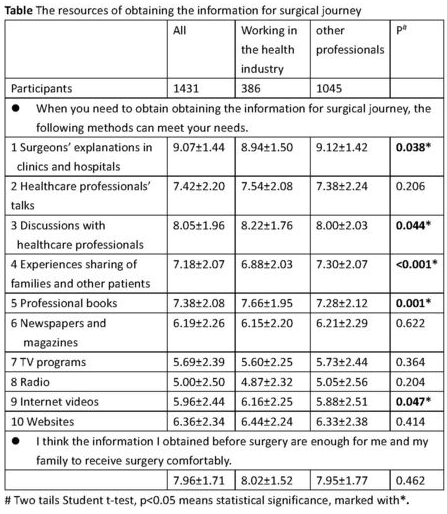PS7-02: HOW THE PUBLIC OBTAIN THE INFORMATION FOR SURGICAL JOURNEYâTHE INITIAL RESULT OF SNOWBALLING RECRUITMENT
Chi-chuan Yeh, MD1, Chiung-Nien Chen, MD2, Hui-Ling Lin, RN3; 11. National Taiwan University Hospital and National Taiwan University College of Medicine, Department of Medical Education, Taipei, Taiwan, 22. Department of Surgery, National Taiwan University Hospital and National Taiwan University College of Medicine, Taipei, Taiwan, 33. Department of Nursing, National Taiwan University Hospital and National Taiwan University College of Medicine, Taipei, Taiwan
Introduction: Health literacy and use and trust in health information has impacts on surgical communications and outcomes. Surgical journey included the pre-, intra-, post-, operative stages. How the public obtain the information for surgical journey has not been well explored. The purpose of this study was to evaluate their needs and the sources and satisfactions of obtaining the information for surgical journey.
Methods: The online questionnaire for evaluating the needs and the sources of obtaining the information for surgical journey were distributed to the public (age >18) by snowballing recruitment via sending e-mails and invitation fliers in an Asia tertiary medical center since September 29, 2019. The scale was 10 points Likert scale (1 totally disagree-10 totally agree). The initial results within two weeks were analyzed.
Results: 1484 participants completed the online survey and 53 data were excluded. The mean age of 1431 included participants was 43.8±11.8. 70% were female and 27% were from the health industry. Majority for obtaining the information for surgical journey were because their family (41%) or themselves (31%) needed surgery. The resources of the information they obtained were analysed and compared between those work in the health industry and other professionals (See the figure). ‘Surgeons’ explanations in clinics and hospitals’ and ‘Discussion with healthcare professionals’ were most satisfied. 97% of participants declared they or their families have received surgery before and 360 responses revealed they obtained the information before surgery were from surgeons. The information they obtained before surgery were enough for they and their family to receive surgery comfortably (7.96±1.71).
Conclusions: We have received 1484 responses quickly within two weeks by using an online questionnaire for evaluating the needs and the sources of obtaining the information for surgical journey by snowballing recruitment. Information from in person contacts to healthcare professionals satisfied them more. The information they obtained before surgery were enough for they and their family to receive surgery comfortably. Future studies will focus on using the results of this survey for designing the interventions for enhancing health literacy in surgical fields.

